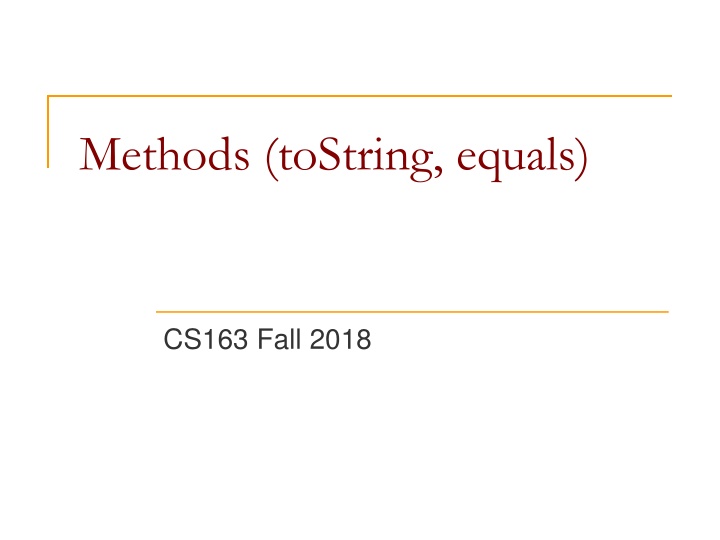
Key Java Methods toString and equals
Learn about the toString and equals methods in Java and how they help with object conversion and equality comparisons. See examples of their implementation and usage in classes and collections. Explore primitive and object equality concepts in Java to enhance your understanding.
Download Presentation

Please find below an Image/Link to download the presentation.
The content on the website is provided AS IS for your information and personal use only. It may not be sold, licensed, or shared on other websites without obtaining consent from the author. If you encounter any issues during the download, it is possible that the publisher has removed the file from their server.
You are allowed to download the files provided on this website for personal or commercial use, subject to the condition that they are used lawfully. All files are the property of their respective owners.
The content on the website is provided AS IS for your information and personal use only. It may not be sold, licensed, or shared on other websites without obtaining consent from the author.
E N D
Presentation Transcript
Methods (toString, equals) CS163 Fall 2018
The toString() method tells Java how to convert an object into a String called when an object is printed or concatenated to a String: Point p = new Point(7, 2); System.out.println( p: " + p); Same as: System.out.println("p: " + p.toString()); Every class has a toString(), even if it isn't in your code. The default is the class's name and a hex (base-16) hash-code: Point@9e8c34 2
toString() implementation public String toString() { code that returns a suitable String; } Example: toString() method for our Student class: public String toString(){ return name: " + name+ "\n" + id: " + id + "\n" + average: " + average; } // SHOW Eclipse example of Student class 3
toString in ArrayLists and other collections call toString automatically ArrayList<Student> students = new ArrayList<>(); System.out.println(students); println(students) calls students.toString(), which automatically calls s.toString() for every point s // SHOW Eclipse example of Student class 4
Primitive Equality Suppose we have two integers i and j How does the statement i==j behave? i==j if i and j contain the same value 5
Object Equality Suppose we have two pet instances pet1 and pet2 How does the statement pet1==pet2 behave? 6
Object Equality Suppose we have two pet instances pet1 and pet2 How does the statement pet1==pet2 behave? pet1==pet2 is true if both refer to the same object The == operator checks if the addresses of the two objects are equal May not be what we want! 7
Object Equality - extended If you want a different notion of equality define your own .equals() method. Use pet1.equals(pet2) instead of pet1==pet2 The default definition of .equals() is the value of == but for Strings the contents are compared 8
.equals for the Pet class public boolean equals (Object other) { if (!other instanceof Pet) { return false; } Pet otherPet = (Pet) other; return ((this.age == otherPet.age) &&(Math.abs(this.weight otherPet.weight) < 1e-8) &&(this.name.equals(otherPet.name))); } // SHOW ECLIPSE EXAMPLE OF Equals code. 9
